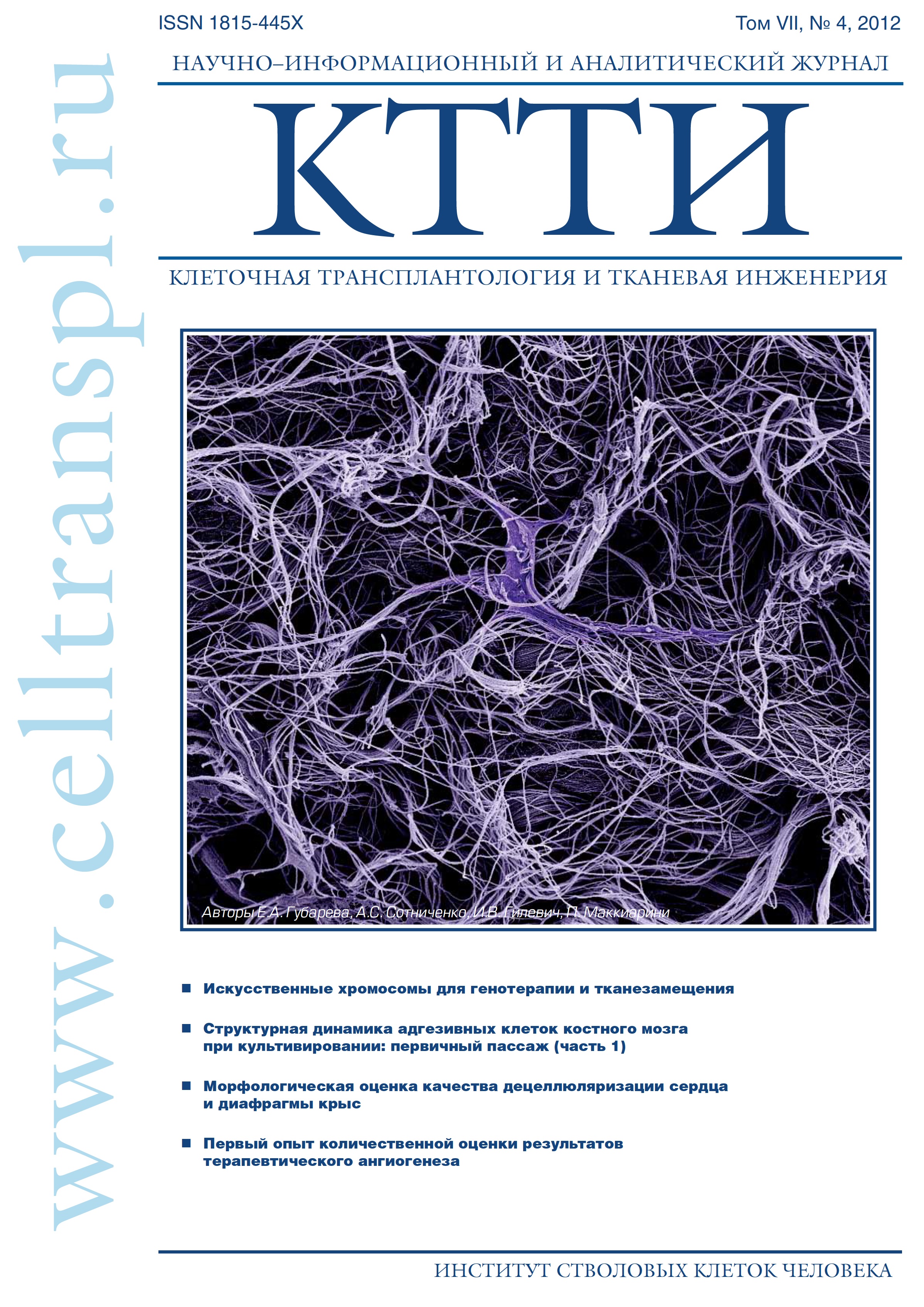Properties of tissue-engineering polycaprolactone matrices impregnated by VEGF and bFGF growth factors
- Authors: Sevostyanova V.V1, Elgudin Y.L2, Wnek G.E2, Lubysheva T.2, Emancipator S.2, Golovkin A.S1, Barbarash L.S1
-
Affiliations:
- Institute for Complex Problems of Cardiovascular Disease of SB RAMS, Kemerovo
- Case Western Reserve University, Cleveland, USA
- Issue: Vol 7, No 4 (2012)
- Pages: 62-67
- Section: Articles
- URL: https://genescells.ru/2313-1829/article/view/121577
- DOI: https://doi.org/10.23868/gc121577
- ID: 121577
Cite item
Abstract
Keywords
Full Text
About the authors
V. V Sevostyanova
Institute for Complex Problems of Cardiovascular Disease of SB RAMS, Kemerovo
Y. L Elgudin
Case Western Reserve University, Cleveland, USA
G. E Wnek
Case Western Reserve University, Cleveland, USA
T. Lubysheva
Case Western Reserve University, Cleveland, USA
S. Emancipator
Case Western Reserve University, Cleveland, USA
A. S Golovkin
Institute for Complex Problems of Cardiovascular Disease of SB RAMS, Kemerovo
L. S Barbarash
Institute for Complex Problems of Cardiovascular Disease of SB RAMS, Kemerovo
References
- Taylor L.M., Edwards J.M., Porter J.M. Present status of reversed vein bypass grafting: five-year results of modern series. J. Vasc. Surg. 1990; 11: 193-205.
- Бокерия Л.А., Беришвили И.И., Солнышков Л.Э. и др. Повторные операции у больных ишемической болезнью сердца - современное состояние проблемы. Бюллетень НЦССХ им. Бакулева РАМН. 2009; 10(3): 5-27.
- Cooper K., Chun I., Colter D., inventors; Ethicon Inc., assignee. Tissue engineered blood vessels. US patent 0,275,129. 2009 Nov 5.
- Tillman B., Yazdani S., Lee S. et al. The in vivo stability of electrospun polycaprolactone-collagen scaffolds in vascular reconstruction. Biomaterials 2009; 30: 583-8.
- Schantz J.T., Chim H., Whiteman M. Cell guidance in tissue engineering: SDF-1 mediates site-directed homing of mesenchymal stem cells within three-dimensional polycaprolactone scaffolds. Tissue Eng. 2007; 13(11): 2615-24.
- Kim K., Luu Y., Chang C. et al. Incorporation and controlled release of a hydrophilic antibiotic using poly(lactide-coglycolide)-based electrospun nanofibrous scaffolds. J. Controll. Release. 2004; (98): 47-56.
- Verreck G., Chun I., Rosenblatt J. et al. Incorporation of drugs in an amorphous state into electrospun nanofibers composed of a water- insoluble, nonbiodegradable polymer. J. Controll. Release. 2003; 92: 349-60.
- Sokolsky-Papkov M., Agashi K., Olaye A. et al. Polymer carriers for drug delivery in tissue engineering. Advanced Drug Delivery Reviews. 2007; (59): 187-206.
- Hakkarainen M. Aliphatic Polyesters: Abiotic and biotic degradation and degradation products. Advances in Polymer Science. 2002; 157: 113-8.
- Sahoo R., Sahoo S., Sahoo S. et al. Synthesis and characterization of polycaprolactone - gelatin nanocomposites for control release anticancer drug paclitaxel. Euro. J. Sci. Res. 2011; 48(3): 527-37.
- Zhu X., Eng M., Tabata Y. et al. Delivery of basic fibroblast growth factor from gelatin microsphere scaffold for the growth of human umbilical vein endothelial cells. Tissue Engineering: Part A. 2008; 14(12): 1939-47.
- Thevenot P., Nair A., Shen J. et al. The effect of incorporation of SDF-1a into PLGA scaffolds on stem cell recruitment and the inflammatory response. Biomaterials 2010; 31(19): 3997-4008.
- Sharon J.L., Puleo D.A. Immobilization of glycoproteains, such as VEGF, on biodegradable substrates. Acta Biomater. 2008; 4(4): 1016-23.
- Sun Q., Chen R., Shen Y. et al. Sustained vascular endothelial growth factor delivery enhances angiogenesis and perfusion in ischemic hind limb. Pharm. Res. 2005; 22(7): 1110-16.
- Guan J., Stankus J., Wagner W. Biodegradable elastomeric scaffolds with basic fibroblast growth factor release. J. Controll. Release. 2007; 120(1-2): 70-8.
- Layman H., Spiga M., Brooks T. et al. The effect of the controlled release of basic fibroblast growth factor from ionic gelatin- based hydrogels on angiogenesis in a murine critical limb ischemic model. Biomaterials 2007; 28(16): 2646-54.
- Wang Y. Liu X.-C., Zhao J. et al. Degradable PLGA scaffolds with basic fibroblast growth factor. Texas Heart Institute Journal 2009; 36(2): 89-97.
- Losi P., Briganti E., Magera A. et al. Tissue response to poly(ether)urethane-polydimethylsiloxane-fibrin composite scaffolds for controlled delivery of pro-angiogenic growth factors. Biomaterials 2010; 31(21): 5336-44.
- Bolgen N., Menceloglu Y.Z., Acatay K. et al. In vitro and in vivo degradation of non-woven materials made of poly(e-caprolactone) nanofibers prepared by electrospinning under different conditions. J. Biomat. Sci. Polym. Edit. 2005; 16(12): 1537-55.
- Ramakrishna S., Fujihara K., Teo W. et al. An introduction to electrospinning and nanofibers. Singapore: World Scientific; 2005.
- Cui W., Zhou Y., Chang J. Electrospun nanofibrous materials for tissue engineering and drug delivery. Sci. Technol. Adv. Mater. 2010; (11): 1-11
- Zong X., Ran S., Kim K.-S. et al. Structure and morphology changes during in vitro degradation of electrospun poly(glycolide- co-lactide) nanofibre membrane. Biomacromolecules 2003; (4): 416-23.
- Smith M. Biologicaly functional scaffolds for tissue engineering and drug delivery, produced through electrostatic processing [dissertation]. Cleveland (OH): Case Western Reserve Univ.; 2010.
- Mandriota S.J., Pepper M.S. Vascular endothelial growth factor-induced in vitro angiogenesis and plasminogen activator expression are dependent on endogenous basic fibroblast growth factor. J. Cell Sci. 1997; 110: 2293-302.
Supplementary files










